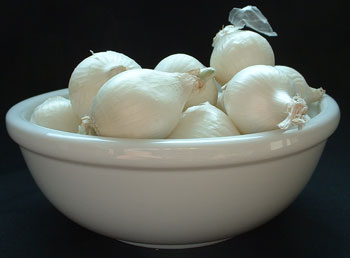
© Denzil Green
Pearl Onions are small pearl-shaped bulbs that are usually ¾ to 1 ¼ inch wide (2 to 3 cm.) Their taste is sweet and mild.
They are grown from many different varieties of onions, most of which would normally grow into regular-sized onions. They are encouraged to grow small in several ways. They can be planted closely together so that they grow small, they can be harvested when still small, or a grower might plant short-day varieties in northern areas (see entry on Short-Day Onions.)
In Europe, a common variety used for Pearl Onions (Allium ampeloprasum L. var. sectevum) produces a clump of small onion bulbs with white skins.
White Pearl Onions are the most common, and the cheapest. White varieties include Crystal Wax (aka White Bermuda.) These have a very small neck, are mostly round, and are ready to harvest from seed in 90 days.
Producers allow them to dry a bit first before shipping them, so that they will store better.
You can buy them fresh, pickled or frozen (frozen will already be skinned.) Fresh ones are usually packaged in small mesh bags, or in boxes, though sometimes they are sold loose. Fresh ones should be heavy for their size.
Cooking Tips
Recipes will often call for different coloured Pearl Onions — this is for visual effect only. If you can’t be asked to have left-over half-bags of 3 different colours, just tell the recipe writer to get stuffed and use one colour.
If you are peeling a lot of Pearl Onions, which are small and fiddly, you can speed up the process by “cold shocking” them. Cut off the tops and the bottoms, then blanch them for up to two minutes, then drain, and dump into very cold water to stop the cooking. When they are cooled, you can just squeeze them to pop them out of their skins.
Can be creamed or cooked in other ways, or pickled.
Substitutes
Grelot onions; small-onions, quartered.
Equivalents
2 cups pearl onions, peeled = approx 250 g / 10 oz

